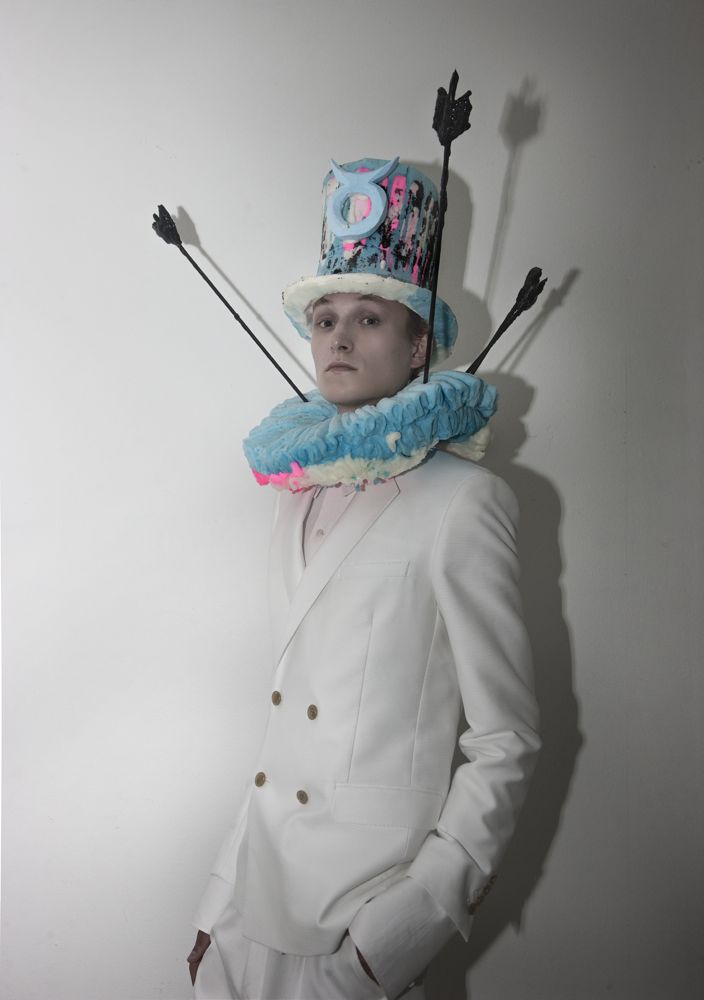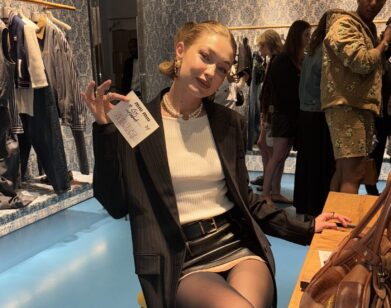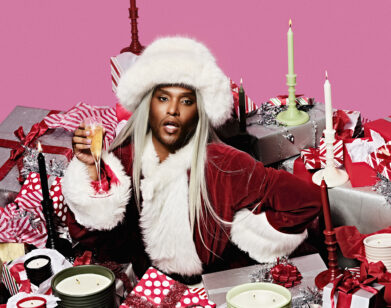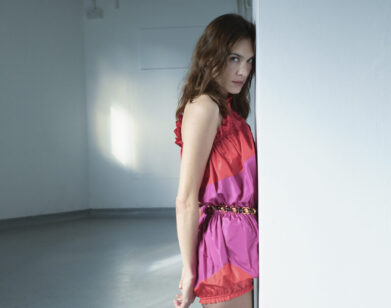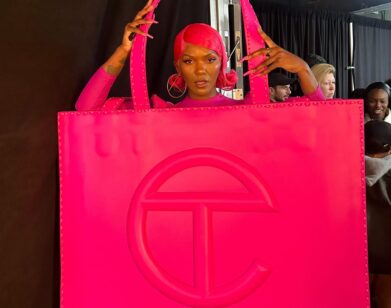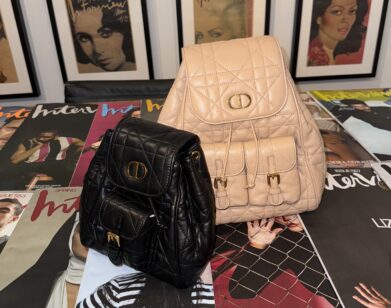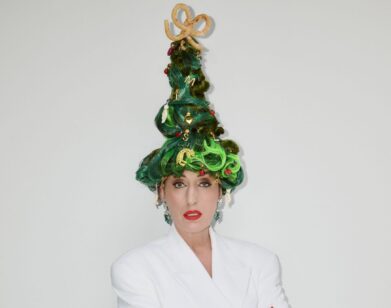Lust, Secrets, and Walter Van Beirendonck’s Beard
Sporting his long signature beard, Walter Van Beirendonck does not look like the average fashion designer. His appearance reflects his work: with his proclivity towards bright colors, threatening masks, esoteric hats, and abstract titles, Beirendonck’s collections are anything but conventional. Part of the revered Antwerp Six, the Belgian designer focused on playful menswear long before Men’s Fashion Week, Tom Ford, and 2000-and-teen dandies, when menswear was still the Siberia of fashion. “I feel better [able] to express myself in that field,” he tells us. “It’s more adventurous, because it’s more difficult to push boundaries in men’s fashion, but still it’s very possible.”
His desire to experiment has worked in his favor, and museums such as the Louvre, the V&A, the Met, and the Musem of Contemporary Art Chicago, have hosted Van Beirendock’s designs. Four years ago, Van Beirendock made his visual art debut at Galerie Polaris in Paris. “In the first place, I’m a fashion designer,” he explains. “I only make art pieces when they really question for it.”
Van Beirendock’s latest exhibition at Dallas Contemporary, however, is something different. “Pete Doroshenko, the director of the museum, was following me for a while,” he tells us. Doroshenko wanted “to show collections that I normally put on a catwalk, to put them in a museum. He was really asking to show a collection as an art installation.”
The two collections featured in the exhibition are recent—from Spring/Summer 2013 and Fall/Winter 2012—and will be displayed on motorized pedestals. They will also be on show in the windows of the new TRAFFIC Los Angeles store in Dallas’ Joule Hotel. We spoke with the designer about the collections in question, hats, and his beard.
EMMA BROWN: Do you think the art world and the fashion world are becoming more intertwined?
WALTER VAN BEIRENDONCK: There is definitely interest from the art world. But in my case, it was always there. I remember even when I did the big fashion shows in the ’90s, the art people were always there. They were really intrigued by the way I was putting together fashion shows and how I was staging it. I think that you could [view] it a little bit like performance art—that type of fashion show. So I have, for a long time, followers that are interested in my work.
BROWN: Can you tell me a little bit about the idea behind your “Silent Secrets” collection?
VAN BEIRENDONCK: I’m showing here in Dallas two collections. The first one is “Silent Secrets,” which is the one from summer, which is now in the shops, and then the other one is “Lust Never Sleeps,” from the winter before. “Silent Secrets” is referring to how secret societies are dealing with that subject. I wanted to bring it into our actual world and refer to social networks. I think that today, it’s really very difficult to keep secrets because everything is spread out immediately all over the world—the question of privacy and still having the possibility to have a secret. The second inspiration was the form of clothing and the dress codes that are used in secret societies, which I interpreted in my own way, in new, contemporary variations.
BROWN: Is it important to keep secrets?
VAN BEIRENDONCK: Yes, I think so. I think you should have at least the possibility. I’m sometimes a little bit shocked [by] how quickly something travels around the world, and how difficult it is to keep something secret. Immediately, pictures are taken by smartphones. Immediately, they’re spreading these images on the Internet. Of course, it’s also part of how we live and how we are working today, but sometimes it’s too quick and too anonymous. These messages and images are not credited anymore, and that is making me a little bit sad. Sometimes you lose the content and you lose the credit of an image.
BROWN: I really love your closing collars with the arrows in them from “Silent Secrets.”
VAN BEIRENDONCK: I forgot to talk about that, it’s important to mention that. The hats and the collars with the arrows and the detailing, it was a collaboration with Folkert de Jong. [He’s] a Dutch sculptor, and I really like his work a lot. When I was sketching my collection, one way or another, I wanted to do something with top hats. I found it really nice to have an accessory that was making a longer silhouette, and was also in line with this masculine dandy person. As a big fan of de Jong, I contacted him and I found out that he liked my work—we were fans of each other. We were working on the top hats and then, at the end, [we] arrived at collars as almost a historical reference, but still very recognizable Folkert de Jong.
BROWN: Do you wear the hats that you create?
VAN BEIRENDONCK: Do I wear them? [laughs] I do sometimes. You mean the top hats, which are in the collection? I didn’t wear them, because I don’t think they’re very practical. But I’m working a lot with Stephen Jones—I did in my previous collections—and I do wear them from time to time if there’s something special going on. I do like to wear the hats, yes. And I’m a big fan of Stephen Jones.
BROWN: Is it strange to revisit such a recent past collection?
VAN BEIRENDONCK: It is strange for me, because it is still very close to me. I already showed a new one, so I have a little bit of distance from these two collections, but I think that also makes it interesting. It is right to have them in a museum now, because [they’re] really questioning our moment in this world—that is what I also like about it. Shall I also tell about the other one, “Lust Never Sleeps”?
BROWN: Yes, please.
VAN BEIRENDONCK: It’s the one with the masks and the bowler hats. For me, when I was working on the collection, there were two main inspirations: voodoo and a kind of future dandyism. I did a lot of research about voodoo and Tahiti: how a lot of people are using these spiritual elements to express themselves. I wanted to give this collection a kind of spiritual atmosphere. I evoked a rather tense effect by putting skin-colored masks—white skin—on top of black-skinned models. For me, it was first of all a graphical effect, but I found out [that] during and after the catwalk presentation people were really questioning why I did that kind of thing. It was mainly to create a kind of tension, which you also feel in this spiritual world. The second thing, the future dandyism, I’m working with much more formal clothing, and sharp and constructed clothing. In this particular case [I referenced] Papua New Guinea’s warrior shields, which were first made in fabric, and then constructed them in them in these kind of suits. So it’s almost like you are creating a person behind the shields, and kind of a protection.
BROWN: How important is it to have this tension in your collections?
VAN BEIRENDONCK: I think it’s important. It’s not that I want to shock—that I’m searching for a shock value. I want to do something that people are questioning, or that they are surprised [by], so that they are seeing something. For me, it’s important to go a little bit further than a normal catwalk presentation.
BROWN: Who are some of your favorite designers at the moment?
VAN BEIRENDONCK: Rei Kawakubo of Comme des Garçons, I still have a lot of respect for her; I think that she’s very brave and she’s very good. She dares to do something totally different and also has the possibility and the will to experiment. I’m sometimes disappointed that—it has a lot to do with the economic situation—but young designers are a little bit less daring today. I think they’re still daring when they graduate and when they’re at school, but afterwards, they’re easily taken away into a kind of more commercial pace, because they’re also a little bit false. That is, of course, a pity. I’m waiting for from fresh voices from the younger generations for the moment. Of course, it’s also a question of surviving, but I think it’s very important that you have a recognizable product, a recognizable suggestion.
BROWN: Did you ever doubt your own voice?
VAN BEIRENDONCK: [laughs] Every day. It is normal. I want to push forward my own boundaries, to go further, experiment, and try things out. Of course, then you’re also critical and sometimes you start to doubt. It’s always just before the presentation: Is it good enough? Did I do the right thing? Once it’s on the catwalk and you’ve got reactions and people do like it, it’s over and you can believe. But it’s a very sensitive process, creating a collection.
BROWN: Last question: when did you first grow your beard?
VAN BEIRENDONCK: [laughs] A long time ago, when fashion designers did not grow beards. It was not done. I think it was around the ’90s, beginning of the ’90s. I already had a very short beard for a while at that time, and I started to grow it. I thought, Why not? I’m going to try it. It was underlining my unconventional fashion look a little bit, because at that time I was already wearing my rings, my earrings, and my biker jacket. I looked more a hard-rock singer than a fashion designer. But I really liked that, because people were sometimes totally shocked when I said I was a fashion designer. I was around other fashion designers and looked so different and so outstanding, but I really enjoyed that. It was also very weird to feel that now, in the last year, beards became so fashionable and suddenly, even long beards, you see them on young people. For a long time, I felt like an outsider, but now I’m like the grandfather of this generation. [laughs]
“LUST NEVER SLEEPS—SILENT SECRETS” OPENS TODAY, APRIL 12, AT DALLAS CONTEMPORARY IN TEXAS AND IS ON DISPLAY THROUGH AUGUST 19.

